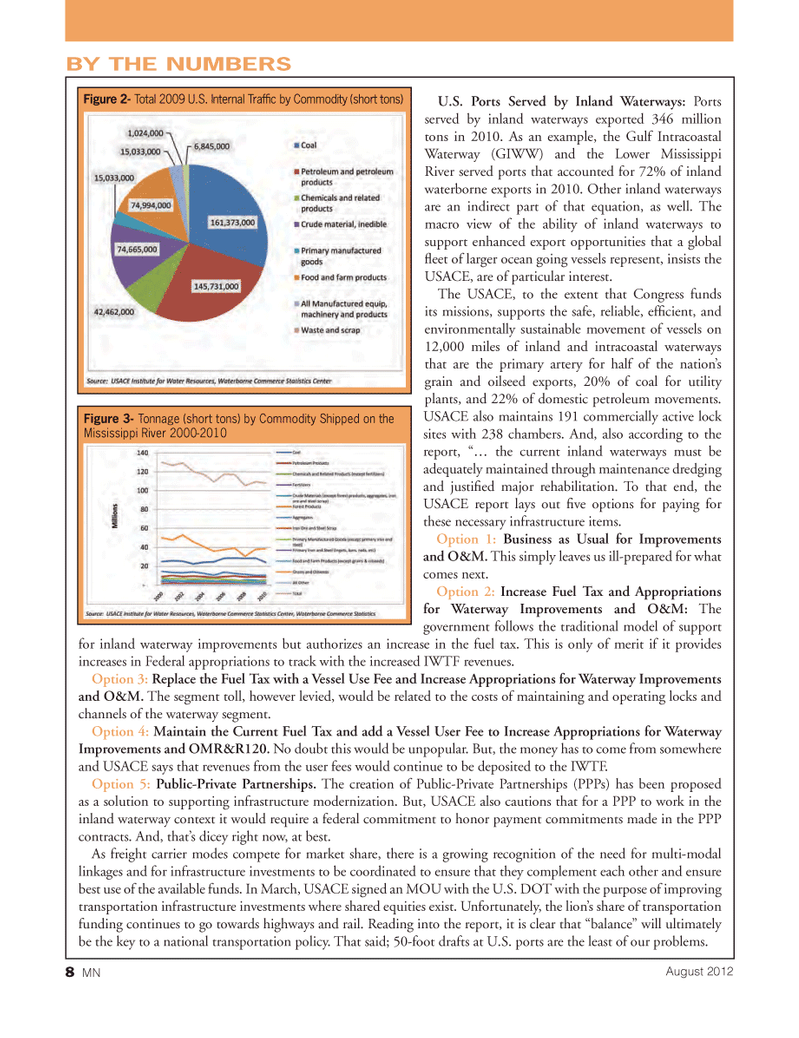
Page 8: of Marine News Magazine (August 2012)
Salvage & Recovery
Read this page in Pdf, Flash or Html5 edition of August 2012 Marine News Magazine
U.S. Ports Served by Inland Waterways: Ports served by inland waterways exported 346 million tons in 2010. As an example, the Gulf Intracoastal Waterway (GIWW) and the Lower Mississippi River served ports that accounted for 72% of inland waterborne exports in 2010. Other inland waterways are an indirect part of that equation, as well. The macro view of the ability of inland waterways to support enhanced export opportunities that a global ß eet of larger ocean going vessels represent, insists the USACE, are of particular interest. The USACE, to the extent that Congress funds its missions, supports the safe, reliable, efÞ cient, and environmentally sustainable movement of vessels on 12,000 miles of inland and intracoastal waterways that are the primary artery for half of the nationÕs grain and oilseed exports, 20% of coal for utility plants, and 22% of domestic petroleum movements. USACE also maintains 191 commercially active lock sites with 238 chambers. And, also according to the report, ÒÉ the current inland waterways must be adequately maintained through maintenance dredging and justiÞ ed major rehabilitation. To that end, the USACE report lays out Þ ve options for paying for these necessary infrastructure items. Option 1: Business as Usual for Improvements and O&M. This simply leaves us ill-prepared for what comes next.Option 2: Increase Fuel Tax and Appropriations for Waterway Improvements and O&M: The government follows the traditional model of support for inland waterway improvements but authorizes an increase in the fuel tax. This is only of merit if it provides increases in Federal appropriations to track with the increased IWTF revenues. Option 3: Replace the Fuel Tax with a Vessel Use Fee and Increase Appropriations for Waterway Improvements and O&M. The segment toll, however levied, would be related to the costs of maintaining and operating locks and channels of the waterway segment. Option 4: Maintain the Current Fuel Tax and add a Vessel User Fee to Increase Appropriations for Waterway Improvements and OMR&R120. No doubt this would be unpopular. But, the money has to come from somewhere and USACE says that revenues from the user fees would continue to be deposited to the IWTF. Option 5: Public-Private Partnerships. The creation of Public-Private Partnerships (PPPs) has been proposed as a solution to supporting infrastructure modernization. But, USACE also cautions that for a PPP to work in the inland waterway context it would require a federal commitment to honor payment commitments made in the PPP contracts. And, thatÕs dicey right now, at best. As freight carrier modes compete for market share, there is a growing recognition of the need for multi-modal linkages and for infrastructure investments to be coordinated to ensure that they complement each other and ensure best use of the available funds. In March, USACE signed an MOU with the U.S. DOT with the purpose of improving transportation infrastructure investments where shared equities exist. Unfortunately, the lionÕs share of transportation funding continues to go towards highways and rail. Reading into the report, it is clear that ÒbalanceÓ will ultimately be the key to a national transportation policy. That said; 50-foot drafts at U.S. ports are the least of our problems. BY THE NUMBERSFigure 2- Total 2009 U.S. Internal TrafÞ c by Commodity (short tons) Figure 3- Tonnage (short tons) by Commodity Shipped on the Mississippi River 2000-20108 MNAugust 2012

 7
7

 9
9
